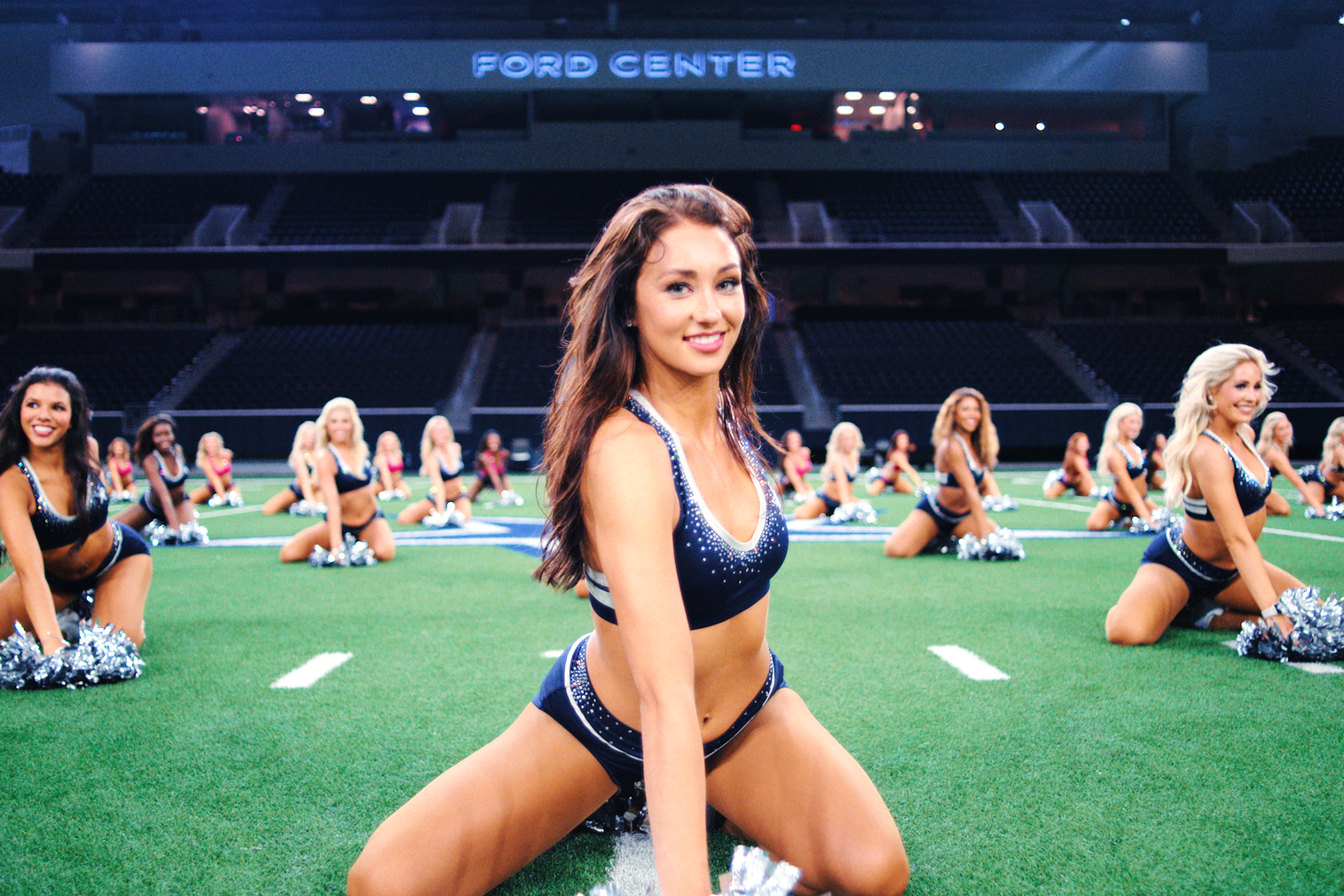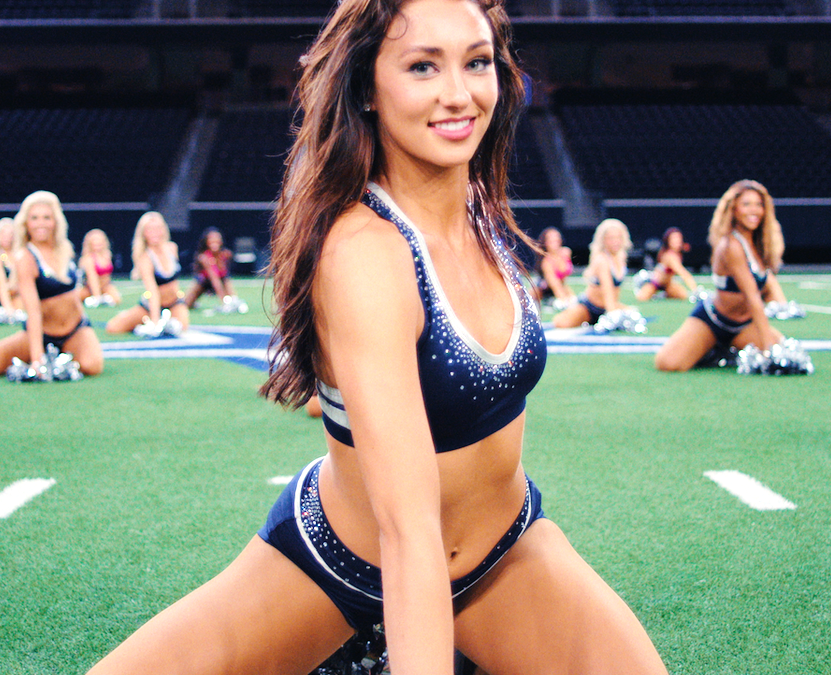America’s Sweethearts: Netflix’s Dallas Cowboys documentary is a dark reminder that when looks are everything there’s no room for anything else
Words by Jessica Barrett

In every scene of the new Netflix docu-series, America’s Sweethearts, which follows 2023’s team of Dallas Cowboys Cheerleaders and their coaches, Kelli Finglass and Judy Trammell, both former DCC themselves, as they audition, rehearse, and perform for the season, you are lambasted with slow motion footage of some of the country’s most beautiful, most accomplished women.
They toss their hair, flash bright, white smiles and pop their hips as they perform some of the most mind boggling dance moves you’ve ever seen (the jump split they execute during their famous Thunderstruck performance will give your pelvis nightmares). And yet, whilst they look, to the rest of us, the picture of perfection, their coaches spend several hours a day analysing their every potential physical snag – no matter how small. One girl is called over for a hushed discussion about rogue, individual, eyebrow hairs which cause Kelli grave concern as she pores over digital photographs of the team’s performance from that same night. Another dancer, five-year veteran Kelcey, is criticised for making a ‘weird’ facial expression as she danced which means she is brutally cut from a performance photograph altogether. One girl is asked about the distance from her belly button to her groin. In fact, anything remotely unique seems to be a red flag when it comes to the hunt for the 36 dancers who will spend the next year representing the team. Their weight is closely monitored, and the girls scour their own videos and photographs for ‘belly rolls’ as they twist and turn during routines.
As he’s a man, it is perhaps not massively surprising that the documentary’s director Greg Whitely, who also directed Cheer and Last Chance U, appears to have only truly noticed the pressures of these exacting beauty standards that are placed on women, particularly those in the public eye, whilst making the series. He said in one recent interview that there was a particular shot of first group leader Kelcey’s eye which caused him to take note. ‘It occurred to me, as we were looking at it, that there is a certain beauty standard, not just for the Dallas Cowboys Cheerleaders, that all women everywhere have to adhere to or strive for,’ he said. ‘I noticed that, as you went into that eyeball, it’s really the one part of the human face that you can’t adjust with makeup, and yet, it is breathtakingly beautiful … Almost to say that, “Yes, here is this beautiful woman, but when you get closer, she becomes more beautiful, not less.” That was what we had found: There’s this organisation, it gleams, and there’s this sisterhood that, yeah, these cheerleaders are beautiful, they dance great—but when you get closer to them, and to who they really are, and to their history, it’s not perfect. It isn’t without its flaws or its cracks. But it’s also more beautiful than I think people accounted for.’
For the Dallas Cowboys Cheerleaders, however, the focus on their looks, in particular their bodies, is a daily concern. There are mentions during practices of girls not ‘fuelling’ their bodies enough and looking visibly pale and weak during one of the daily practices which often go well into the night. We learn that the dancers aren’t paid much. One alumni, Kat, compares her salary to that of ‘a Chick-fil-A worker who works full time’ – and while Dallas Cowboys players can make tens of millions of dollars a year, most of the cheerleading squad are also forced to work day jobs to make ends meet.
There is no more poignant reminder of the effects this kind of pressure can have on young women than Victoria Kalina, the 24-year-old tragic heroine of the whole series whom we witness struggling with depression, anxiety, and an eating disorder. The fourth-year veteran dancer reflects, during one confessional on the series, on how she has struggled deeply with her mental health and body image while on the team.
‘The tiny uniforms are certainly a motivator for the team’s obsession with remaining slim’
‘I’ve never been open about it, but my depression turns into this bad cycle,’ Victoria says, quietly. ‘Whenever I get into a bad depression, I turn to bad coping skills, which causes bad eating habits. And as a dancer, the hardest thing you can fight are eating disorders plus depression. I go through the cycle when that depression zone hits. It’s a binge-purge cycle. It’s a binge to get that feel-good, that empty feeling filled again. But then game time comes, so then you gotta get into those baby clothes, get into that baby uniform, and that cycle just keeps going.’
We hear a lot over the course of the documentary about how unforgiving the DCC’s famous uniform of cropped vest, midriff top, and hot pants is for the dancers. But it is the women who must change their bodies to fit that uniform, not the other way around.
The tiny uniforms are certainly a motivator for the team’s obsession with remaining slim, you hear a lot of talk about diets and weight gain or loss in the course of the eight episode run. And the pressure to never put a foot wrong is great – you are, after all, following in the footsteps of hundreds of women before you (the team was first launched in 1961). Being a Dallas Cowboys Cheerleader isn’t just about dancing, it’s about the ‘American Dream’. The cheerleading team’s official motto is ‘often imitated, never equalled’. Though they’re not greatly paid, the 36 dancers are required to not only perform at weekly matches, attend regular rehearsals, and fulfil a gruelling annual audition stage, they are also expected to be pillars of the community, completing charity work and doing hospital visits.
There are some very real risks associated with their cheerleading work, too. Not only is there the risk of injury (some of the girls, in their early twenties, have already undergone hip surgery), there is also the risk from the men they dance for. In one episode, Kelcey recounts the time a stalker put an AirTag on her car. She drove home before she realised what had happened, and admits she was too terrified to sleep for weeks, worrying about what could happen to her. In the same episode, an on-pitch photographer gropes Sophy, the team’s youngest dancer, while she’s performing and she reports him to the DC’s security who alert the police.
Charlotte Jones, the Cowboys’ chief brand officer and daughter of the team’s owner Jerry Jones, makes a condescending assumption of the DCC team: ‘There’s a lot of cynicism around pay for NFL cheerleaders—as it should be. They’re not paid a lot,’ she says. ‘But the facts are, they actually don’t come here for the money. They come here for something that’s actually bigger than that to them. They have a passion for dance. There are not a lot of opportunities in the field of dance to get to perform at an elite level. It is about being a part of something bigger than themselves. It is about a sisterhood that they are able to form, about relationships that they have for the rest of their life. They have a chance to feel like they are valued, they are special, and they are making a difference. When the women come here, they find their passion and they find their purpose.’
Wouldn’t it be wonderful, however, if they could find their purpose and find themselves properly financially compensated? These dancers are at the peak of their profession, and yet they are treated as merely a sparkly support for the well-paid men they share the pitch with. They are deeply cared for by Kelli and Judy, that much is clear, but there is a cut-off when it comes to pastoral care that feels difficult to watch. America’s Sweethearts feels like a throwback to the difficult viewing we were subjected to in shows like America’s Next Top Model: women are critiqued for their looks with little regard for the long term effects it might have. It’s a window into the reality of being a woman, albeit on a turbo-charged, sequin-clad level: and unsurprisingly, there are some uncomfortable, dark truths to be discovered
Photo: Netflix

